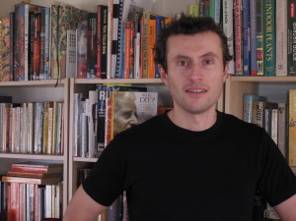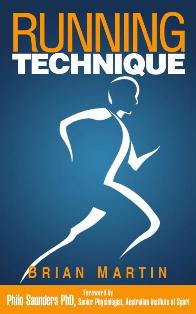
In 2011 I launched a blog called Running Technique Tips, published an eBook and started helping recreational runners in Melbourne, Australia to train towards better running technique.
My book has sold over 3,000 copies and Running Technique Tips was recognized in Outside Magazine’s top 10 running blogs.
I think this modest level of success has been driven by a determination to cut through the science speak and arrive at simpler explanations of the critical factors needed to improve running technique. Thousands of runners have now benefited from adopting at least some of my ideas. My primary goal was to empower runners of any ability with the knowledge and practical training approaches to improve and enjoy their running.
I’m like every other runner, namely, not well versed in the unintelligible language of anatomy, movement and injury. I write in plain English so you don’t have to sit and read my work with a heavy biomechanics or medical text book on your lap.
We live in an age of gurus and it makes me cringe that anyone would consider me as one. Let me be clear - no one person has all the answers when it comes to running. What I’ve continued to do is communicate and teach the factors that could be considered the 80:20 of running. This is the stuff that anyone can readily understand, practice and train for in the long term.
Much of it is common sense and if you have a great running coach you may already be well and truly on the right track. The problem is there are millions of self-coached runners following cookie-cutter running programs that make no allowance for the individual, nor do they provide a foundation in basics such as strength training and running form.
A couple of years of coaching recreational runners to improve technique and my own ongoing running experiments have kept my feet firmly on the ground. Teaching and explaining movement is a difficult business and I’ve continued to learn that keeping things simple and doing the basics well is the best way to proceed. This book captures much of what I’ve learned and builds on my previous work. By returning to an old school running coaching tool like form drills I hope to give runners another simple way to learn the basics of running well.
I’m the first to admit that there are no silver bullets in running, but imagine being in charge of your destiny and exerting conscious control of what you’re seeking to achieve? This is what a little knowledge and awareness can bring to your running experience. It will be hard work and of course there will be bad days, niggles and the occasional injury, but I’d take that any day in exchange for the know-how to train towards more good days than bad.
This book explains how to do each running form drill but most importantly gives you an insight into how each drill can help you recognize and learn the running movement patterns taught by good coaches for decades.
Put simply you can use Running Form Drills as a tool to help you learn how to run.
I hope this short book adds something useful to your toolkit of training techniques and brings you those small moments of joy in discovering a better way to move.
Nothing lifts the spirits like a good run.

Brian Martin
September 2013
Supporting online resources: I’m a big fan of the written word as a foundation of teaching and learning. However, there is also much to be gained by watching video to assist in developing your understanding of the running movement patterns discussed in this book. Please take the time to visit the resources located at my website: http://www.runningtechniquetips.com/running-form-drills/
Some generous reviews from my readers - thank you all for your support:
A number of readers have been kind enough to provide positive reviews of my first book Running Technique and also suggest improvements along the way. I’m grateful for all the feedback and support I’ve received from readers of my book, blog and runners that have sought me out in Melbourne for help with their running technique and strength training programs.

Explores the theory and practice of developing
good running form, along with plenty of suggested exercises and
training methods. Brian is a thoughtful, balanced voice in the
raging debate on what constitutes good form, so his thoughts are
worth checking out. Alex Hutchinson
http://goo.gl/mTbj4D
This is a must read for all runners. While 'Born to Run' by Christopher McDougall has provided a compelling case to run, this book will show you how to do it best. Mossy.
I no longer have knee injuries. Running Technique was the book I was looking for, I'm only a casual runner, but was always getting knee injuries. The running technique book has allowed me to understand what muscles are involved in running and removed a lot of problems I had with my stride. Andrew.
I would recommend it to anyone (save my enemies). SuperFitVegMan.
One of the best running books that I've ever read! It explains the mechanics of running very well so you finally understand the right/wrong things that you do while running. You begin to see that a good technique is not only about being a forefoot or heel striker but much more than that. Seda Serhatli.
Running Technique is a priceless work that helps to describe a part of the running/training puzzle that few books tend to leave out. Running Technique covers the specific supplemental (weights/core) and biomechanics part that will take your running to a new level. Nick Stanko.
Wish I read this 25 years ago! I came across this book while recovering from a calf injury and it went a long way to explaining where I've been going wrong with my running over my lifetime. The advice given in this book matched up exactly with what my Physiotherapist was saying and has really opened my eyes. Glenn Reid.
This book has given me new hope. The cheapest and BEST resource I've come across after years of frustration searching elsewhere. Thank You! I've been trying to understand why as a petite woman I've got cartilage damage and how I can prevent any further damage. This book has given me new hope. Sharla Hall.
This is THE Holy Book of Running. If you ever wanted to learn how to run like the pros then this book will teach you how. It covers all anatomical aspects of running, the various phases, the muscles used and drills/weight lifting tips. At long last we have an author that recognizes the importance of weightlifting to fire the correct muscle sequences for efficient, injury free running. Darrell.
****
A special thanks to all the readers of my book and blog. At times this project has been an overwhelming and thankless task, but an occasional email from a reader, comment on the blog, positive tweet or book review has encouraged me to continue to believe that what I’m doing is helpful and worth continuing to pursue.
Thanks again to coach Mark Gorski who has helped me learn more about coaching and offered me plenty of support. He’s also been the voice of reason that has culled some of my more left field ideas before they see the light of day.
I’d also like to thank other members of the online and worldwide running community for their support. Those that have mentioned me in their blog posts, linked to my articles, shared my work on social media have earned a big thank you. I couldn’t have gotten this far without you.
Most of these people I’ve never met in the real world but I’m certain I’d like them if I did! I’m hoping to catch-up with some of these fine people in the coming years. I’d especially like to thank Peter Larson, Peter Vigneron, Alex Hutchinson, James Dunne, Craig Payne, Mark Cucuzzella, Greg Strosaker, Silas Moss, Dave Robertson, Jen Brown, Matt Phillips, Stephen Cauchi, Curb Ivanic and the team at Run 4 Your Life Magazine in Australia.
A big thanks to Dylan, Chris, Dan and Mac from Fitline PT in Melbourne for giving us a place to play.
Encourager in chief Lisa - thank you.
Finally if I’ve forgotten anybody I humbly apologize, feel free to let me know about it!
****